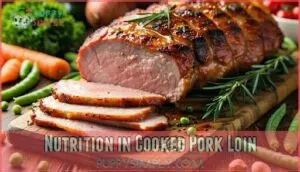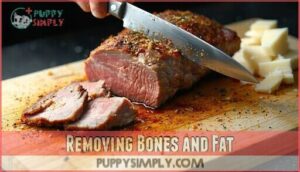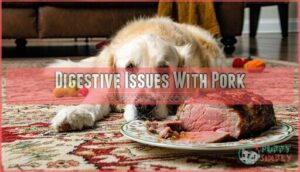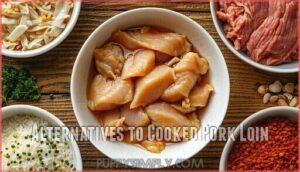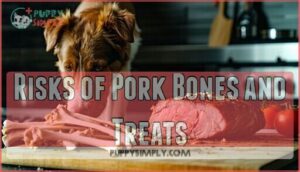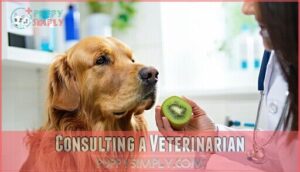This site is supported by our readers. We may earn a commission, at no cost to you, if you purchase through links.

Make sure it’s fully cooked, plain, and free of bones, seasoning, garlic, or onion, which can be toxic to dogs.
Pork loin is lean, making it a good protein option if served in moderation.
Avoid excess fat, as it can upset your dog’s stomach or even lead to pancreatitis.
Also, watch out for portion sizes—treats like this shouldn’t replace their balanced diet.
Like introducing any new food, start small and monitor for allergies or tummy issues.
Curious about safer cooking methods or portion tips? Stay tuned.
Table Of Contents
- Key Takeaways
- Can Dogs Eat Pork
- Is Cooked Pork Loin Safe
- Nutrition in Cooked Pork Loin
- Preparing Cooked Pork Loin
- Digestive Issues With Pork
- Alternatives to Cooked Pork Loin
- Risks of Pork Bones and Treats
- Consulting a Veterinarian
- Frequently Asked Questions (FAQs)
- Can dogs eat pork tenderloin?
- Can dogs eat pork?
- Can dogs eat pulled pork?
- Can dogs eat pork rinds?
- Can dogs eat pork chops?
- Can dogs eat pork sausage?
- Is It Safe to Feed Cooked Pork Loin to Puppies?
- Are There Any Health Benefits From Consuming Cooked Pork Loin?
- Can I feed my dog cooked pork loin?
- Why can’t dogs eat cooked pork?
- Conclusion
Key Takeaways
- Dogs can eat cooked pork loin, but make sure it’s plain, fully cooked, and free of bones, seasoning, garlic, or onion.
- Always trim excess fat to prevent stomach upset or pancreatitis, and serve in moderation to avoid overfeeding.
- Watch for allergic reactions or digestive issues when introducing pork to your dog’s diet, starting with small portions.
- Cook pork loin to a minimum of 145°F to eliminate harmful parasites and ensure it’s safe for your dog.
Can Dogs Eat Pork
Yes, dogs can eat pork, but it depends on how it’s prepared.
When cooked plain and served in moderation, pork can be a safe and nutritious treat for your dog.
Benefits of Cooked Pork for Dogs
Cooked pork loin can be a fantastic addition to your dog’s diet, delivering a blend of taste and health benefits.
It’s a highly digestible protein, ensuring better nutrient absorption and muscle support.
Here are the top perks:
- Muscle Support: Complete protein profile aids development and repair.
- Coat Health: Essential fatty acids promote a shiny, healthy coat.
- Energy Source: Vitamins B12, zinc, and potassium support energy.
When served plain and lean, pork loin adds variety to your dog’s menu, combining palatability factors with nutrition.
Moderation is key to accessing the full pork benefits for your dog’s health.
Risks of Raw and Processed Pork
Feeding your dog raw or processed pork can bring more problems than benefits.
Raw pork carries risks like bacterial contamination and parasitic infections, particularly trichinosis caused by Trichinella spiralis. Symptoms include vomiting, fever, and fatigue—always cook thoroughly to prevent this.
Processed pork, such as bacon, ham, and sausages, is loaded with salt and additives. These can lead to sodium poisoning, digestive upset, or even carcinogenic effects.
Stick to plain, cooked pork loin to avoid these dangers and keep your pet healthy and happy. The World Health Organization warns about consuming undercooked pork, emphasizing the importance of proper cooking to prevent bacterial contamination and ensure a safe diet for your dog, which is crucial for their overall health and happiness.
Is Cooked Pork Loin Safe
When adding cooked pork loin to your dog’s diet, be cautious. Always cook it to at least 145°F to eliminate harmful parasites—safe cooking temperatures matter!
Stick to plain pork; safe seasonings exclude garlic and onion, which are toxic to dogs. Trim excess fat to prevent pancreatitis.
Portion control is key—adjust servings based on your dog’s size and weight. Watch for breed sensitivities since some dogs may have pork allergies.
Cooked bones splinter, posing a risk of internal damage. Talk to your vet to avoid long-term effects on dog health.
Nutrition in Cooked Pork Loin
Cooked pork loin is packed with high-quality protein and essential nutrients like vitamin B12, zinc, and iron, which support your dog’s overall health.
It’s also a great option for lean, easily digestible protein, making it suitable for dogs with sensitive stomachs, providing high-quality protein.
Protein Content in Pork
Packed with protein, pork loin offers a top-tier option for your dog’s diet, with 3 oz providing about 38g of protein—talk about a nutritional powerhouse.
This high-quality protein supports muscle building, tissue repair, and overall dog health.
Here’s why pork shines as a protein source:
- Amino Acids: Delivers essential building blocks for health.
- Digestibility Score: Beats some other meats, making it easy on digestion.
- Protein Quality: Stands tall even against chicken for muscle building.
Your dog’s nutrition thrives with such a rich, wholesome protein.
Omega-3 Fatty Acids in Pork
Pork omega-3s are relatively scarce, especially in typical pork loin, making it less ideal for boosting omega-3 fatty acids in your dog’s diet.
Most pork has a high omega-6 to omega-3 ratio, unlike fish, which remains the gold standard for omega-3 benefits.
Some pork, like heritage breeds or wild boar, offers better ALA conversion and fat quality, but standard pork shouldn’t replace fish for dog nutrition or health.
Carbohydrates in Pork
In the context of pork carbohydrates, pork loin keeps things simple—it contains zero carbs.
That means this protein-packed option won’t impact your dog’s glycemic index, making it ideal for low-carb canine diets.
Instead of being an energy source, pork serves as a lean protein and fat content provider, supporting muscle growth and repair.
Its lack of carbs fits into any dog nutrition plan focused on limiting carb impact.
Keep this in mind when balancing protein sources in your dog’s diet.
Preparing Cooked Pork Loin
When preparing cooked pork loin for your dog, stick to plain cooking methods like baking or boiling without adding seasonings, spices, or oils.
Be sure to remove all bones and excess fat to keep it safe and easy for your dog to enjoy.
Cooking Methods for Pork Loin
To prepare pork loin safely for your dog, stick to these simple cooking techniques that lock in flavor and nutrition:
- Baking pork loin: Roast at 350°F until the internal temperature hits 145°F—this guarantees thorough cooking while retaining tenderness.
- Slow cooking pork: Let it simmer on low for 6-8 hours, creating tender, flavorful meat that’s easy to chew.
- Pan-searing loin: Cook in a non-stick pan with no oil or seasonings until fully done.
Consider using a quality pork roaster for even cooking.
Avoid serving raw pork—it poses risks like trichinella parasites. Always prioritize safe preparation for your dog’s health!
Removing Bones and Fat
Safety starts with careful preparation. Before serving cooked pork loin to your dog, focus on bone identification and **safe removal.
Cooked bones splinter easily, posing serious choking hazards or potentially causing internal injuries. Trimming excess fat is just as important—this simple fat trimming step helps prevent pancreatitis, a painful condition for dogs. Opt for lean pork cut choices free from seasoning. It’s worth investing a few extra minutes in this process to make certain your pup enjoys a safe, tasty treat. Consider professional [dog bone removal](https://zon.everysimply.com/dog+bone+removal/dp/) tools for enhanced safety. Always use thorough preparation methods** to keep your dog happy and healthy with every meal.
Serving Size Guidelines
After trimming fat and removing bones, let’s talk about portion control for feeding dogs pork loin.
The right serving depends on Individual Dog Needs like size and activity. Here’s a quick guide:
- Extra-small dogs (2–10 lbs): 1 piece (½-inch size).
- Small dogs (11–20 lbs): 1–2 pieces.
- Medium dogs (21–50 lbs): Up to ¼ cup.
- Large dogs (51–90 lbs): ½ cup max.
- Extra-large dogs (91+ lbs): 4–5 pieces.
Monitoring Pork Intake guarantees pork stays an occasional treat, within the Daily Pork Limit of 10%.
Every pup deserves a balanced dog diet!
Digestive Issues With Pork
Feeding your dog pork can sometimes lead to digestive problems like vomiting, diarrhea, or bloating, especially if it’s high in fat.
It’s essential to monitor your pet closely and introduce pork gradually to avoid upsetting their stomach, making digestive care a priority.
Pancreatitis Risk in Dogs
Feeding pork to your dog might seem harmless, but its fat content can upset their stomach.
Dogs, especially breeds like Miniature Schnauzers, often struggle with high-fat pork, which strains their pancreas.
This can lead to pancreatitis, a serious condition where the pancreas becomes inflamed and stops functioning properly.
Symptoms include vomiting, diarrhea, and lethargy.
Managing your dog’s diet with leaner options is key to reducing risks.
If you suspect pancreatitis symptoms, seek veterinary intervention immediately for guidance on safer feeding practices for your dog’s health.
Allergic Reactions to Pork
Pork allergies in dogs can sneak up unexpectedly, often causing symptoms like itching, flaky skin, or inflamed ears.
If you spot these signs after feeding pork, consider allergy testing options to pinpoint triggers.
Managing pork allergies may require switching to alternative proteins like duck or wild boar.
Remember, certain breeds are more prone to dog allergies, so consulting your veterinarian guarantees your pup stays comfortable and itch-free!
Introducing Pork to Dog’s Diet
Adding pork to your dog’s diet takes patience and care. Start with small portions to gauge tolerance and watch for signs of allergies like itching or upset stomach.
Gradually increase serving sizes over time. Always use plain, fully-cooked pork loin for its lean benefits.
Consult your vet for advice based on breed or health needs.
- Begin small: Tiny portions work best.
- Monitor closely: Spot allergies early.
- Increase slowly: Avoid digestive shocks.
- Stay hydrated: Make certain water is accessible.
Alternatives to Cooked Pork Loin
If cooked pork loin isn’t the right fit for your dog, there are plenty of healthy alternatives worth exploring.
Leaner proteins like chicken, turkey, or even wild boar can provide the nutrition your pup needs without the added fat.
Wild Boar as a Novel Protein
Wild boar is a fantastic option for your dog’s diet if they struggle with allergies to common proteins like pork or chicken.
It’s lean, packed with thiamin, omega-3s, and zinc, and highly digestible.
Even better, its foraged diet means a smaller carbon footprint, making it a sustainable meat choice.
As a novel protein, wild boar offers a nutritious, eco-friendly, and safe alternative for allergy-prone pups needing something unique in their dog food.
For pups needing alternatives, consider a grain-free natural kibble.
Leaner Protein Sources for Dogs
Why settle for less when you can explore Poultry Options, Fish Choices, and Plant Proteins for your dog’s nutritional needs?
Chicken breast offers a superb lean protein source with excellent Protein Digestibility, making it gentle on sensitive stomachs.
Fish, like salmon or whitefish, provides essential nutrients and healthy fats, supporting overall health.
Plant Proteins can round out a balanced dog diet, complementing Novel Proteins like pork loin, delivering leaner alternatives, ensuring your furry friend’s protein source is both nutritious and sustainable.
Eco-Friendly Meat Options
When exploring eco-friendly meat options for your dog’s diet, consider choices like wild boar or pasture-raised meats.
These alternatives emphasize sustainable pork practices, ethical sourcing, and lower carbon footprints. Wild boar is leaner and easier to digest than pork loin.
Supporting responsible farm practices and reduced packaging aligns your pet’s diet with sustainability. Consider eco-friendly dog food for a sustainable choice.
Choosing safe foods like these guarantees your pup enjoys nutritious, human-grade options while fostering a planet-friendly dog food approach.
Risks of Pork Bones and Treats
Giving your dog pork bones might seem harmless, but it can lead to serious health risks.
Cooked bones can splinter easily, causing choking or internal injuries that require immediate veterinary care.
Choking Hazards With Pork Bones
Pork bones may seem like a treat, but they’re a serious choking hazard.
When chewed, they splinter easily, creating sharp edges that can harm your dog.
Bone splintering risks include:
- Intestinal blockages from large fragments.
- Choking caused by lodged pieces.
- Esophageal damage from sharp bone edges.
- Dental injuries during chewing.
Raw bones also present bacterial contamination risks.
Opt for rawhide alternatives or safer chews, and always supervise your dog with any treat.
Splintering Risk With Cooked Bones
Cooked pork bones can turn dangerous quickly.
Once cooked, bones lose flexibility and splinter easily, posing risks like blockages, tissue tears, or severe pain.
The bone size doesn’t matter—it’s still a choking hazard, especially for smaller dogs.
Cooking methods only make splintering worse.
If you’re focused on your dog’s health, skip pork bones entirely.
Safer alternative chews offer the joy of gnawing without jeopardizing digestion or causing unnecessary vet visits, promoting overall wellness.
Safer Alternatives to Pork Bones
For safer options than pork bones, try dental chews or synthetic bones designed to support your dog’s oral health without risking bone splinters.
Vegetable chews provide a healthy, crunchy alternative, while rawhide alternatives can also keep your pup entertained.
Edible bones specifically made for dogs are another great way to manage dog choking hazards safely.
Prioritizing your dog’s well-being means avoiding splintering risks and opting for alternatives that cater to both nutrition and fun, ensuring safety with every chew.
Consulting a Veterinarian
If you’re unsure about feeding your dog cooked pork loin, reaching out to a veterinarian can provide clarity and personalized advice.
They can help you understand potential risks, recommend safe serving practices, and address any concerns about your dog’s unique dietary needs.
Signs of Adverse Reactions
After feeding your dog cooked pork loin, monitor for unusual behaviors.
Watch for these signs of adverse reactions:
- Vomiting signs and diarrhea symptoms, indicating digestive upset.
- Skin irritation or swelling, which may suggest allergies.
- Lethargy indicators like unusual tiredness or mood changes.
These symptoms could point to anaphylactic shock or a reaction to toxic foods. If you notice anything concerning, contact your vet immediately to keep your dog safe.
Dietary Recommendations for Dogs
A balanced diet designed to your dog’s life stage and activity level is essential for their wellbeing.
Always prioritize hydration needs and consult your vet before changing your dog’s diet, including introducing cooked pork loin.
Follow these dog dietary guidelines:
- Practice portion control to avoid overeating.
- Limit reliance on pork as a primary protein source.
- Add supplementation if advised by your vet.
- Adjust meals based on your dog’s energy levels.
Proper planning guarantees a healthy, happy dog.
Emergency Situations With Pork Consumption
If your dog shows symptoms like bloating, vomiting, or trouble breathing after eating pork, contact your vet immediately.
Watch for allergic reactions, pancreatitis signs, or salt poisoning. Never ignore symptoms of bone obstruction or trichinosis.
Dog pork risks can escalate fast, so prompt veterinary care is key to handling these emergency situations. Stay alert and act quickly to address any issues that may arise, as prompt action is crucial in such cases.
Frequently Asked Questions (FAQs)
Can dogs eat pork tenderloin?
Imagine giving your pup a bite of plain, cooked pork tenderloin.
They’ll enjoy the protein boost, but skip the spices, fat, and bones.
Serve fully cooked and in moderation to avoid digestive issues or potential allergies.
Can dogs eat pork?
Yes, dogs can eat cooked pork if it’s plain, fully cooked, and served in moderation.
Avoid seasonings, bones, and excess fat, as these can cause health issues like pancreatitis or choking hazards.
Safe portions are essential.
Can dogs eat pulled pork?
Nearly 90% of processed pulled pork contains harmful additives like salt or spices.
It’s not safe for dogs due to seasonings like onion or garlic powder.
Opt for plain, unseasoned, cooked pork instead.
Can dogs eat pork rinds?
Pork rinds aren’t safe for dogs.
They’re high in fat and salt, which can cause stomach upset, dehydration, or pancreatitis.
Stick to healthier treats, as these crunchy snacks aren’t worth the potential health risks.
Can dogs eat pork chops?
Dogs can eat plain, fully-cooked pork chops in moderation if you remove the bones and excess fat.
Avoid seasoning or spices, as they can harm your dog.
Always monitor for any adverse reactions after feeding plain pork chops.
Can dogs eat pork sausage?
You shouldn’t let your dog eat pork sausage.
It’s full of seasonings, salt, and fat that can upset their stomach or even harm them.
Stick to plain, cooked pork for a safer treat.
Is It Safe to Feed Cooked Pork Loin to Puppies?
Feeding cooked pork loin to puppies is safe if it’s plain, thoroughly cooked, and free of bones, spices, or seasonings.
Start with small portions to confirm their tummy handles it well, and monitor closely.
Are There Any Health Benefits From Consuming Cooked Pork Loin?
Cooked pork loin offers plenty of health perks for dogs.
It’s packed with lean protein to build muscles, B12 to boost nerve health, and zinc for immune strength.
Serve plain and in moderation for best results.
Can I feed my dog cooked pork loin?
Yes, you can feed your dog cooked pork loin, but keep it plain and free of seasoning.
Cook it thoroughly to eliminate bacteria, remove any bones or excess fat, and offer it in moderation.
Why can’t dogs eat cooked pork?
Imagine sharing a family meal, but pork isn’t always a safe choice for your dog.
It’s risky due to high fat, potential spices, and splintering cooked bones, which can cause digestive trouble or choking hazards.
Conclusion
Cooking pork loin for your dog is like mastering a good recipe—keeping it simple makes all the difference.
Yes, dogs can eat cooked pork loin if it’s plain, boneless, and free of harmful additives like garlic or onion.
Its lean protein benefits your dog’s health when served in moderation, and watching for portion size is crucial.
Avoid excess fat, and always monitor your pup for any reactions.
Done right, cooked pork loin can be a safe, occasional treat for your furry friend.


